Sparrowhawk
Accipiter nisus
The sparrowhawk is named after the fact that it hunts down and consumes sparrows
Advertisement
Sparrowhawk Scientific Classification
- Kingdom
- Animalia
- Phylum
- Chordata
- Class
- Aves
- Order
- Accipitriformes
- Family
- Accipitridae
- Genus
- Accipiter
- Scientific Name
- Accipiter nisus
Read our Complete Guide to Classification of Animals.
Sparrowhawk Conservation Status
Sparrowhawk Facts
- Prey
- Birds, insects, rodents, and other mammals
- Fun Fact
- The sparrowhawk is named after the fact that it hunts down and consumes sparrows
- Estimated Population Size
- Several million
- Biggest Threat
- Habitat loss
- Most Distinctive Feature
- The barred plumage on the breast
- Other Name(s)
- Sparhawks
- Wingspan
- Up to 101cm (40in)
- Incubation Period
- A month
- Habitat
- Forests and woodlands
- Predators
- Eagles, owls, falcons, goshawks, red foxes, and martens
- Diet
- Carnivore
- Type
- Bird
- Common Name
- Sparrowhawk
- Number Of Species
- 20
- Location
- Europe, Asia, Africa, and Oceania
- Nesting Location
- Tall trees
- Age of Molting
- 1-2 months
- Migratory
- 1
View all of the Sparrowhawk images!
The sparrowhawk is an expert hunter of sparrows and other birds.
Sparrowhawk refers to any number of species that belong to the hawk genus. It should not be confused with the American kestrel, also known as the sparrow hawk, which actually belongs to the falcon genus instead. The most common and widespread species is probably the Eurasian sparrowhawk, which will be the focus of this article unless otherwise mentioned.
3 Sparrowhawk Amazing Facts
- The sparrowhawk has been used in the sport and pastime of falconry for hundreds of years, but it has a reputation of being difficult to train.
- The sparrowhawk plays a central role in some Slavic mythology. It is also featured in numerous poems and plays by William Shakespeare and other writers.
- After eating, the sparrowhawk will produce small pellets that contain indigestible parts of its prey.
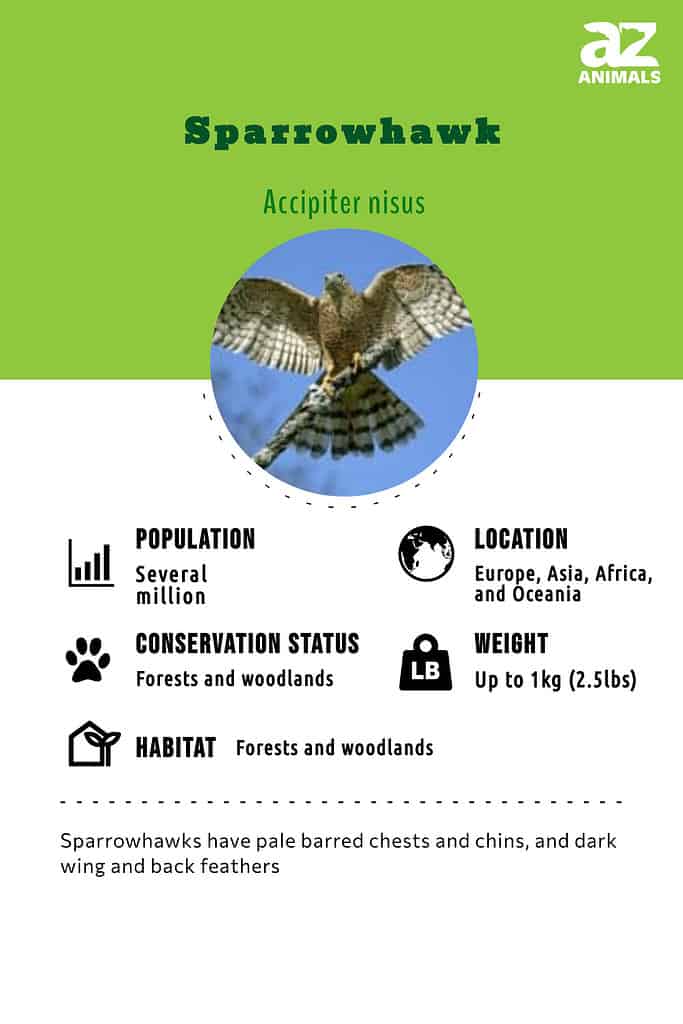
Where to Find the Sparrowhawk

Sparrowhawks prefer wooded areas which provide the cover and shelter they need
©Dennis Jacobsen/Shutterstock.com
The sparrowhawk can be found throughout most of Europe, Asia, Africa, and the Pacific region. They often take up residence in forest and woodland areas, which provide plenty of cover and nesting locations.
Nests
The sparrowhawk may create a nest composed of twigs and bark in the forked branch of a tall tree.
Scientific Name
The scientific name for the sparrowhawk genus is Accipiter. It is a Latin word that means hawk or bird of prey. However, not all species within the genus are considered to be sparrowhawks. Most are goshawks or “true” hawks. Only about 20 of the 51 or so species go by the name sparrowhawk. The family to which they belong also includes eagles, kites, and other birds of prey.
Size, Appearance, and Behavior
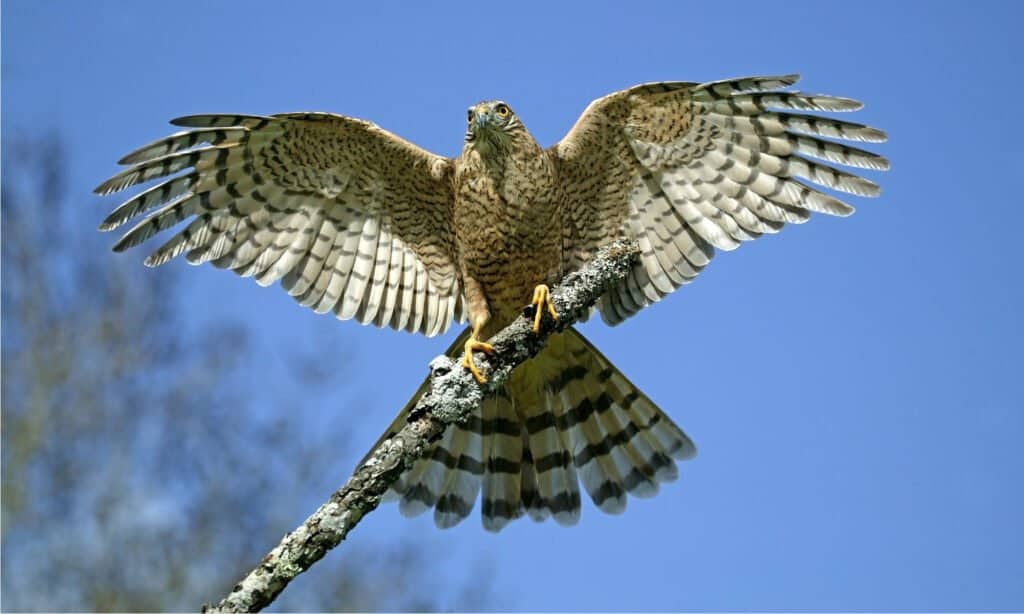
Female sparrowhawks weigh twice as much as males
©slowmotiongli/Shutterstock.com
Sparrowhawks come in a variety of different colors and patterns, but most species have solid gray or black upper wings with a white breast and lower wings covered in orange or brown barred markings. The short, broad wings and long, slender tail may help it maneuver through the trees, while the sharp beak and talons are used to kill prey. Females are substantially larger than males. For instance, the female Eurasian sparrowhawk is about 25% larger and weighs twice as much as its male counterpart. The largest female sparrowhawks can easily reach up to 20 inches tall with a wingspan of up to 40 inches.
The sparrowhawk is, for the most part, a solitary hunter. They are mostly silent outside of the breeding season, but they do make a chattering or cackling call that sounds like “kewkewkew.” This call is likely directed toward other members of its species. There is no specific name for a group of sparrowhawks, but some people use aerie or eyrie to describe them.
Migration and Timing
Most populations are resident for the entire year, but northern sparrowhawks do migrate south for the winter. For example, populations in Siberia can travel all the way down to southern Eurasia and Africa each year.
Evolution and Classification
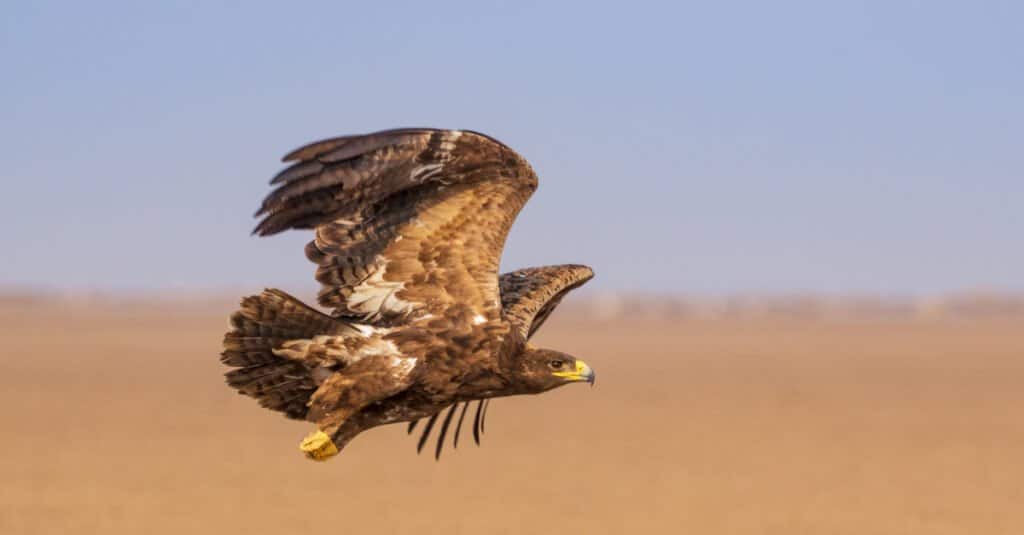
Eagles, hawks, harriers, and kites are also related to sparrowhawks
©Hardik Shelat/Shutterstock.com
Owing to their status as members of the Accipitridae, sparrowhawks are also related to other birds of prey which also belong to the same family. Included in that select group are eagles, harriers, hawks, kites, and even vultures.
Their membership in the family also makes them part of the order Accipitriformes. (A group of birds of prey and carrion eaters which appeared during the Eocene era, i.e., 34 – 56 million years ago.) Hence they are also related to the following:
- Cathartidae: Included in this family are the Black vulture, the turkey vulture, and the Andean condor.
- Pandionidae: This family is made up solely of ospreys.
- Sagittariidae: The secretary bird is the sole member of this family.
Types
There are six subspecies of the sparrowhawk, including:
- Accipiter nisus nisus: This subspecies winters in the Mediterranean, the Middle East, and Pakistan. It however returns to Europe to breed.
- Accipiter nisus nisosimilis: This subspecies winters in southeastern and eastern Asia as well as Africa. It prefers to breed in eastern Asia.
- Accipiter nisus melaschistos: A larger avian compared to A.n nisus and A.n nisosimilis, this subspecies breeds at high altitudes in the Himalayas, Tibet, China, and Afghanistan. It heads to south Asia for the winter.
- Accipiter nisus wolterstorffi: The smallest member of the family, this subspecies lives in Corsica and Sardinia.
- Accipiter nisus granti: This subspecies which is small-sized and covered in dark plumage lives in the Canary Islands.
- Accipiter nisus punicus: This subspecies can be recognized by its light-colored plumage. It lives in northwest Africa.
Diet
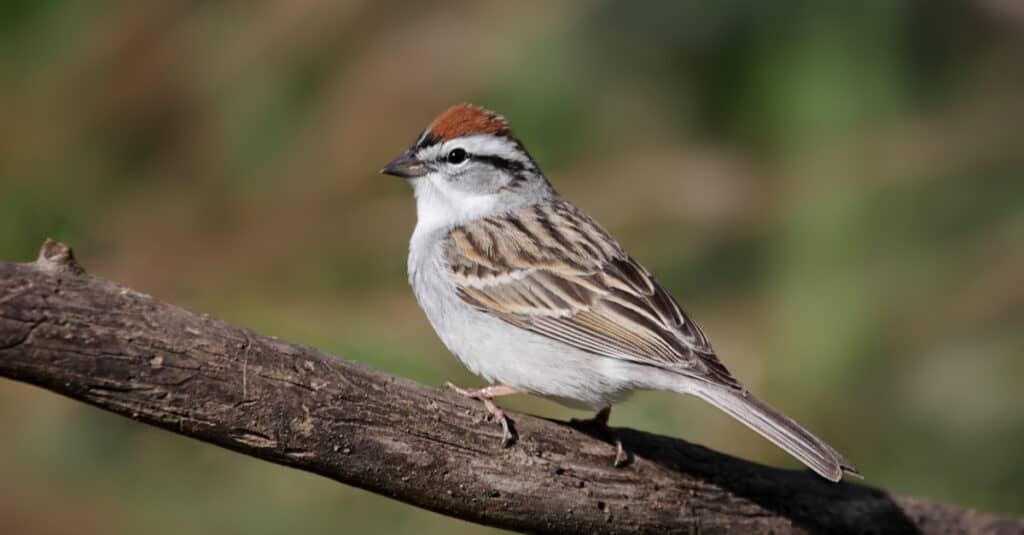
Sparrows are a favorite food item of sparrowhawks
©Steve Byland/Shutterstock.com
Like all birds of prey, the sparrowhawk is a carnivorous animal. In order to find food, they remain hidden in cover and then ambush their prey with sudden speed and agility. They are likely to target a single prey and relentlessly hunt it until it’s captured.
What does the sparrowhawk eat?
The diet of the sparrowhawk usually consists of sparrows and finches. They will also consume insects, rodents, and other small mammals if given the opportunity. They will often pluck the feathers from the dead prey and tear the flesh off with its sharp beak. The entire prey is consumed and very little is left behind.
Predators, Threats, and Conservation Status
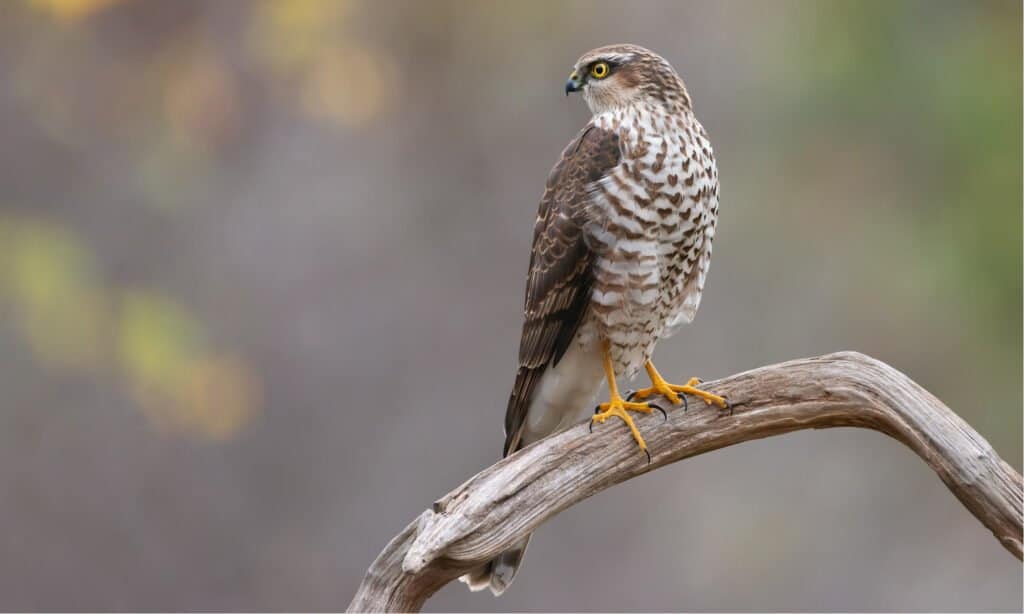
Sparrowhawks are doing well population-wise, with the exception of the Nicobar and New Britain sparrowhawks
©Kalina Georgieva/Shutterstock.com
Sparrowhawks face several threats from humans. They are particularly vulnerable to habitat loss because they depend so much on thriving woodlands. Pollution also affects them by thinning out their shells. They are sometimes hunted and killed by humans as well. According to the IUCN Red List, most sparrowhawks are considered to be species of least concern, meaning populations are robust and they require no special conservation effort. But a few of the Pacific species, such as the Nicobar sparrowhawk from the Nicobar Islands and the New Britain sparrowhawk from Papua New Guinea, are either vulnerable or near threatened. Habitat destruction is a big reason why.
What eats the sparrowhawk?
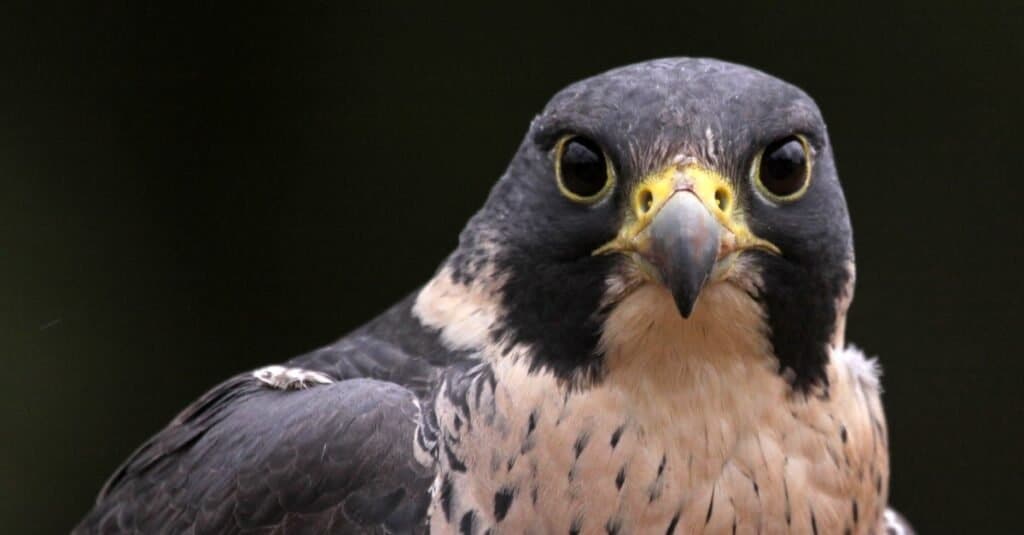
Falcons are known to prey on sparrowhawks. They are however part of a long list of predators which include eagles, owls, and foxes
©Chris Hill/Shutterstock.com
The sparrowhawk is sometimes preyed upon by eagles, owls, falcons, goshawks, red foxes, and martens. The size and ferocity of the adult provide plenty of protection against predators, but juveniles are more at risk.
Reproduction, Young, and Molting
Many sparrowhawks breed in extensive woodland areas that provide just enough space for easy flight. Most species are completely monogamous within the breeding season, but they can change mates each year whenever it suits them. They tend to remain in the same territory year after year to produce and raise their brood. After mating, the female will produce a single clutch of two to five eggs (depending on the species) per breeding season. These eggs will hatch after about a month of incubation.
The mother takes care of the chicks for the first few weeks, while the male provides much of the food. The chicks are completely dependent on the parents at this stage and make loud calls for food. After about a month, the chicks will start to perch on branches and learn to fly. This is done in preparation for permanently leaving the nest a short time later. The mortality rate is very high in this early period. It’s estimated that only about a third will survive the first year. Most juveniles take about one to three years to fully achieve sexual maturity. Assuming they reach adulthood, most sparrowhawks have a normal lifespan of 10 to 20 years.
Population
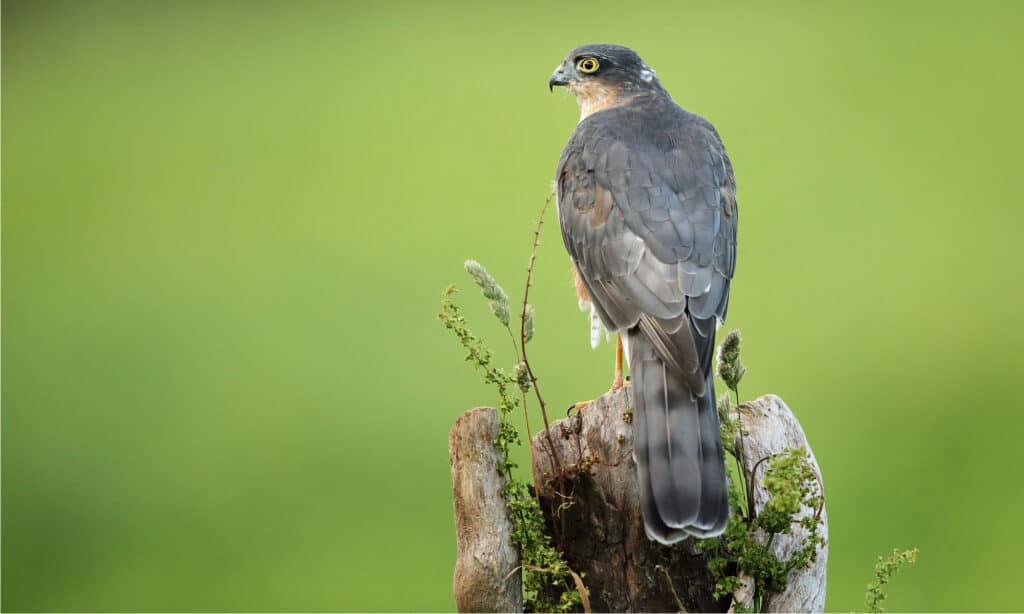
The Eurasian sparrowhawk is the most abundant subspecies while the Nicobar sparrowhawk is the rarest
©Edwin Godinho/Shutterstock.com
Population numbers vary by species. The Eurasian sparrowhawk has an estimated population of at least two million mature individuals in the wild. The Chinese sparrowhawk has an estimated population of around 270,000 to 667,000 mature individuals, although numbers are decreasing. Perhaps the rarest species is the Nicobar sparrowhawk with only about 2,500 to 5,000 mature individuals remaining on the small island chain near Indonesia.
View all 293 animals that start with SSparrowhawk FAQs (Frequently Asked Questions)
Does the sparrowhawk migrate?
Yes, northern sparrowhawk populations do migrate south for the winter.
How many eggs does the sparrowhawk lay?
Sparrowhawks lay several eggs, usually in the range of two to five per breeding season.
How fast does the sparrowhawk fly?
The sparrowhawk flies at an average speed of around 30 to 40 miles per hour, but it can probably achieve a top speed of around 50 mph.
What is the sparrowhawk’s wingspan?
The largest species (like the black sparrowhawk) have a wingspan up to 39 or 40 inches.
When do sparrowhawks leave the nest?
The chicks generally leave the nest after about a month or two.
What is a sparrowhawk?
The sparrowhawk is a type of hawk or bird of prey that, as the name suggests, primarily preys on smaller birds such as sparrows. It belongs to the hawk genus, but keep in mind that the distinction between sparrowhawks and other types of hawks isn’t always clear-cut and obvious.
How big is a sparrowhawk?
Sparrowhawks generally don’t grow much larger than 20 inches tall.
Is it rare to see a sparrowhawk in your garden?
If sparrows, finches, and other potential prey reside in your garden, then you may receive a visit from a sparrowhawk from time to time, but the garden is not their preferred hunting grounds.
Are sparrowhawks rare?
Sparrowhawks are very common across their entire range.
Do sparrowhawks eat rats?
Yes, they do eat rats on occasion, but their primary source of food is actually other birds.
How do I identify a sparrowhawk?
Sparrowhawks can be identified by the broad wings, long, slender tail, dark and solid-colored upper wings, and barred or striped breast and lower wings. They are fairly small for a bird of prey but still much larger than most birds.
Thank you for reading! Have some feedback for us? Contact the AZ Animals editorial team.
Sources
- , Available here: https://www.britannica.com/animal/sparrowhawk
- , Available here: https://animaldiversity.org/accounts/Accipiter_nisus/
- , Available here: https://birdfact.com/birds/sparrowhawk

















